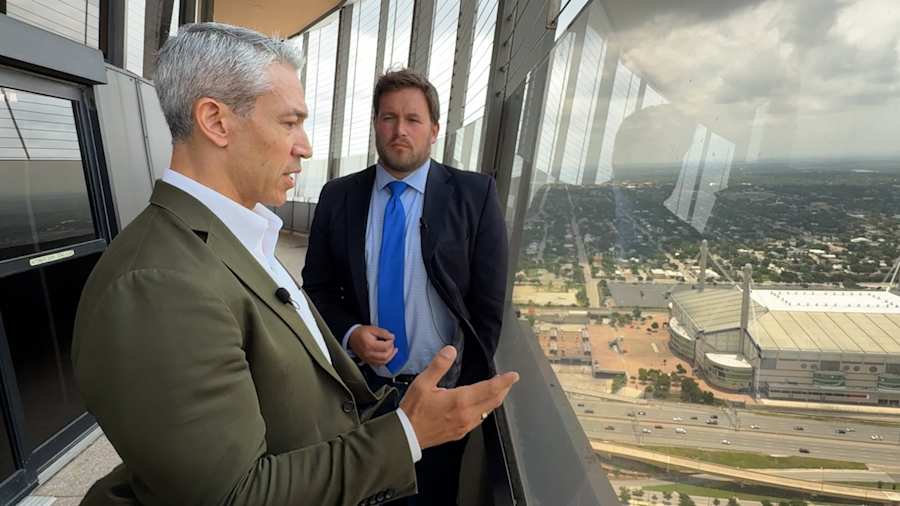SAN ANTONIO – After eight years at the head of San Antonio’s city government, Mayor Ron Nirenberg is preparing to step down.
The former District 8 Councilman was first elected as mayor in 2017 after defeating Ivy Taylor in a runoff election. Forced out by term limits, he will leave office on Wednesday, June 18, when Mayor-elect Gina Ortiz Jones and the other city council winners of the June 7 runoff election are sworn in.
Nirenberg’s time as mayor has been marked by the COVID-19 pandemic, attempts to tackle entrenched city problems — such as generational poverty and mass transit — as well as multiple downtown stadium projects.
The mayor met KSAT at the Tower of the Americas on June 13 to discuss the past eight years and the projects he’s handing off to a new city council, including the controversial Project Marvel.
Watch KSAT 12’s extended interview with Nirenberg below.
The following transcript of the interview has been edited for clarity and to smooth the transitions between different locations during the interview.
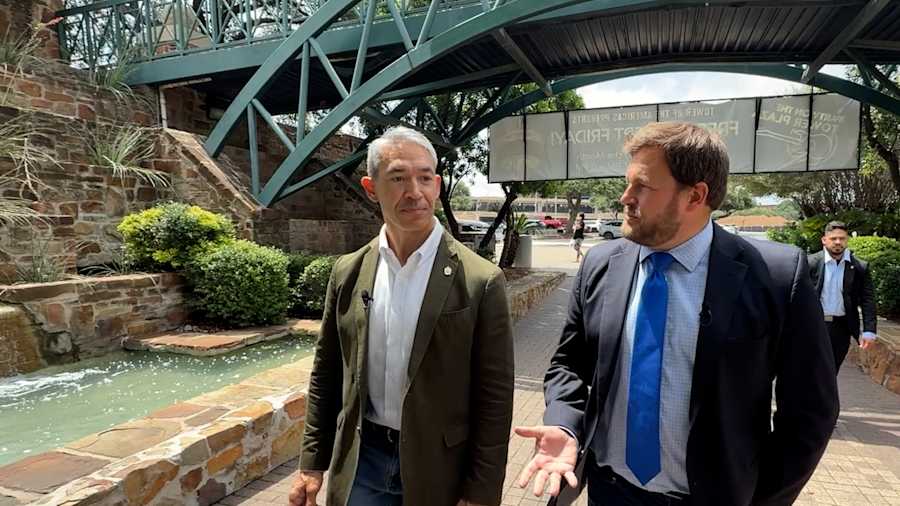
WALKING INTO THE TOWER OF THE AMERICAS
KSAT: Can you tell me a little bit about the path to the mayor’s office? You came in as a two-term councilman, but before that, you weren’t in politics. You were managing a radio station. So, how do you go from that (to) mayor of the city? What was the path? What was the vision?
NIRENBERG: Well, it was really just the vision of being a citizen of this city and being very interested in its future as a parent and as a resident. And I got involved in a lot of different community-building activities. I started participating in the SA 2020 process, and I just got inspired to do more. And I took a flyer on running for city council. Where else can you do that but in American democracy? Be an average person to run because you want to invest your time and effort into the community that you love. I wasn’t unfamiliar with politics, but it certainly wasn’t part of my plan.
KSAT: After four years as a councilman, what made you decide to run for mayor and go all the way to the top?
NIRENBERG: Well, at the time we were going through a transition, and I felt myself, found myself increasingly at odds with the mayor at the time. And I got into this work and this job not because I wanted to be a council member, be the mayor. It was really because I wanted to make an impact on my community. And so, as that transition happened and I found myself more and more on an island politically within the council, but also aligned with the community and the vision that we articulated as a city through SA 2020, I thought, “You know, the only way I can continue to make the impact that I think the community wants us to make is to change the conversation and run for mayor.” And so, that’s what I did in order to continue to advance the work and the community vision that was articulated during that period of time.
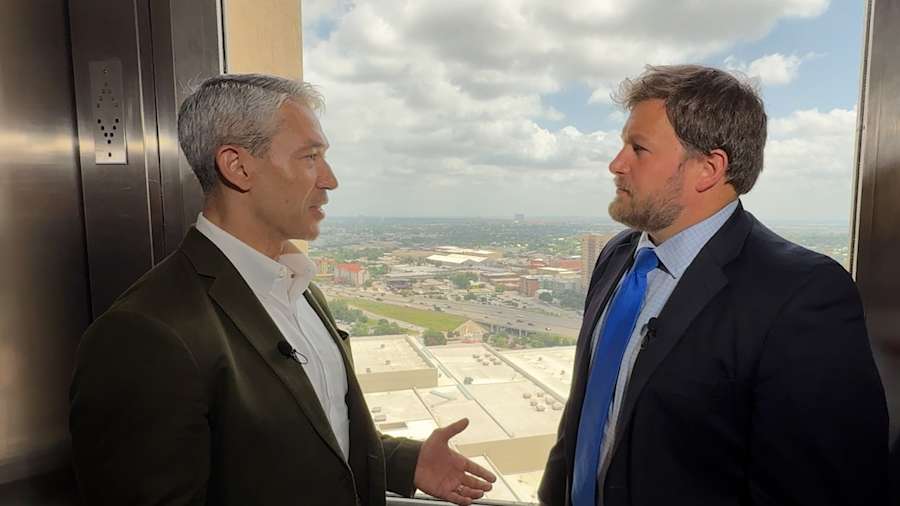
KSAT: 2017, you win in a pretty close runoff. Tell me about the feeling as (you’re) ascending to power.
NIRENBERG: So, this is a classical American democracy where community members really are elected to represent the community that they live in. And that was me. As mayor of the city, I was a resident of the city, and I was elected to carry forward a vision for the city. And so, I always stayed — despite rising to the highest levels of political authority in the city — I always stay grounded in my city. You know, the best work that we ever do is making sure — is when we are grounded in our community, walking around our neighborhoods, in the streets, listening to our residents and making sure that we’re carrying out the aspirations that they have for our community.
ARRIVING AT CHART HOUSE RESTAURANT AND LOOKING OUT OVER THE CITY
KSAT: When’s the last time you’ve been up here?
NIRENBERG: It’s been a few years. Last time I was up here, I think, was for a post-New Year’s Eve fireworks celebration.
KSAT: Which fireworks were you watching? Official ones, or the East, West and South Side?
NIRENBERG: Actually, now I remember. It was actually after a Fiesta Fiesta. The fireworks after the opening of Fiesta a few years ago. This is an amazing city. And part of this is, we have — our community has big dreams, big aspirations. We’re the seventh most populous city in the United States. There’s a history of challenge in this city, you know, that we have a well-storied... We have many documented challenges with respect to socioeconomic equity and making sure that people have an opportunity to thrive. And so, part of my work has been to ensure that whoever you are in the city, you have an opportunity to live a good life, find a great place to live, a safe place to live, be able to pursue your education, and get a good job that helps you advance your career, raise your family and enjoy the community that you live in. And I’ve been very fortunate to be able to steward that kind of city.
KSAT: It is a pretty cool place to live.
NIRENBERG: It’s changing for sure. I mean, and it’s one of the most unique cities in America with respect to the history and cultural mix that continues to be elevated even while we become this 21st-century metropolis. We’re overseeing Hemisfair right now. This is a site of constant transformation, where we had the World’s Fair in 1968, but now it’s the sort of the nexus of what we are seeing in the transformation of downtown into a place of residence and unemployment and education. So, it’s very exciting.
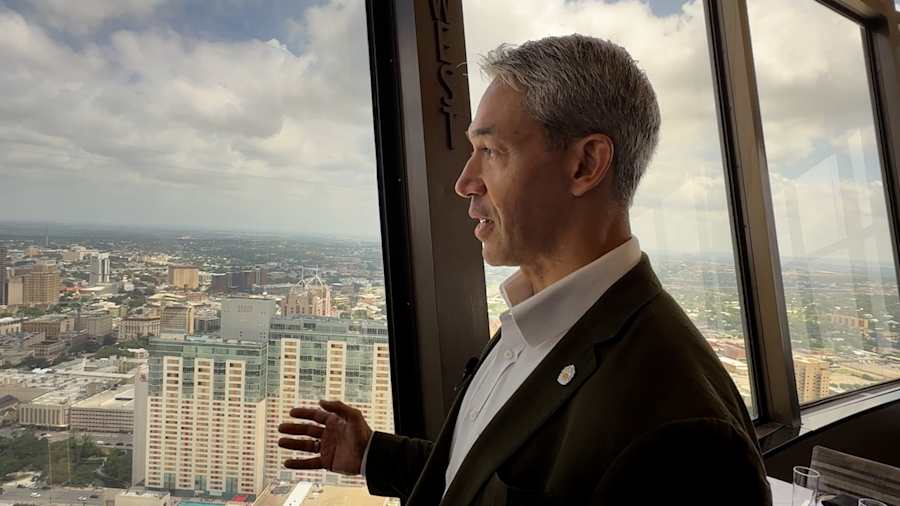
KSAT: What’s your favorite part about the city? What’s you’re favorite thing?
NIRENBERG: It will sound trite when I say this, but it’s really the people. There’s a spirit in this city and a soul in this city that is unmistakable and also irreplicable: a social cohesion. This is a city where for literally hundreds, if not thousands of years, people have congregated from all over the place. We’re geographically in the middle of a lot of different corridors of human mobility. And yet, despite all those cultural differences, those different belief systems, we’re a place that people find common ground in.
And that’s why I think we have such a great social cohesion. We’re a military city. People work out conflict here and build community together in a way that is very unique. And we’re a bi-national city. We’re a multi-cultural city, but specifically we’re a bi-national city with respect to the presence of Mexican and American culture and influence. And that’s unmistakable in every aspect of our lives.
WALKING ALONG THE TOWER’S WINDOWS
KSAT: Eight years in office, you faced a lot of challenges. What do you think was the hardest one?
NIRENBERG: Well, there’s been a lot of different kinds of challenges: political challenges, economic challenges. I would say, obviously, going through a global health crisis is not easy. But the greatest challenge in this city, given our political system, has been to really keep our eyes forward and develop and implement a long-term agenda. I always talk about the fact that nothing meaningful happens unless we have teamwork, and also, we are staying committed in a generational sense.
You know, the work that we’re doing to provide people good jobs with good wages through education, the work we’re just doing that we just started today with breaking ground on our first mass transit system, the housing efforts in this city, what we’re doing to bring more equitable access to health care — all those things take yearslong commitments. So they will outlast whatever political authority, whatever administration is there.
And so, the greatest challenge is to keep people committed to that forward progress. I’ve been very lucky that over the last eight years, despite two-year terms, the public has supported our work repeatedly, year after year, on the ballot, directly. They’ve re-elected me and my colleagues to carry out that work. So, now the next challenge will be to ensure that there’s forward progress for the next administration to continue that work.
KSAT: So one of the hallmarks of your administration, and you just mentioned voters, supporting (you) on the ballot. Right during the middle of the COVID pandemic, you pushed for a jobs training program, sales tax-funded, “Ready to Work.” Voters had heard the numbers, “10,000 for each of four years.” Three years into it, we’ve got less than 12,000 enrolled, and the percentage of people being placed within appropriate jobs within six months is a little less than 60%.
So the numbers are coming in lower than I think what many people were expecting. You’ve been adamant that this is still a program worth pursuing. Can you talk about, though, do you feel it’s falling short of expectations?
NIRENBERG: So, let’s start from the beginning. Those initial numbers that came out were simply calculated based on how much money do we have to facilitate people going through a workforce training program. And so, with “X” amount of sales tax dollars over a four-and-a-half-year period, we could afford 40,000 people to go through that pipeline.
Now what we are doing is actually now getting people into that pipeline, working with them to get trained up and ultimately placed in a job. It takes time because it’s about real life. And so, it’s not that those numbers are much different. In fact, we’re going to get tens of thousands of people into new jobs through this program. What people didn’t — what we should be clear on is that in order to get somebody into the workforce pipeline, they’re going to have to overcome a lot of barriers — whether it’s child care, transportation, a health event, or whatever.
Ready to Work is that last opportunity. And what’s powerful about this program is that the average participant in the Ready to Work program is coming from a household income of $14,500 a year. When they are placed in a new job, they’re making on average $44,000 a year, with benefits. They are a single mom raising children in that household. So, you can imagine the transformation that occurs within that single household. Now those children are much more likely to pursue their own education and get into a job, allow their children and grandchildren to thrive. You’ve changed the cycle of poverty. And so, if we can do that for a single family, that is transformative over a course of generation. If we can do that for 10 families, for 100 families, for 1,000 families.
Now, you’re talking about exponential change that’s occurring in our community. So what I’m clear on is that Ready to Work is changing and breaking the cycles of poverty in the city that have gripped our community for so long. The impact, economic impact, to the family is profound. The economic impact to our city is even larger. So, this remains a critical investment for our city if, in fact, we are sincere in our desire to change the level of poverty in the city. And if we can break poverty in this city, we also have the benefit of improving social outcomes, health outcomes. Crime rates are lower in areas with lower poverty rates. So, all of the things that we spend so much money on fixing, if we can work upstream from that and make sure that families can thrive by getting a good education and good jobs, there’s not more valuable investment than that.
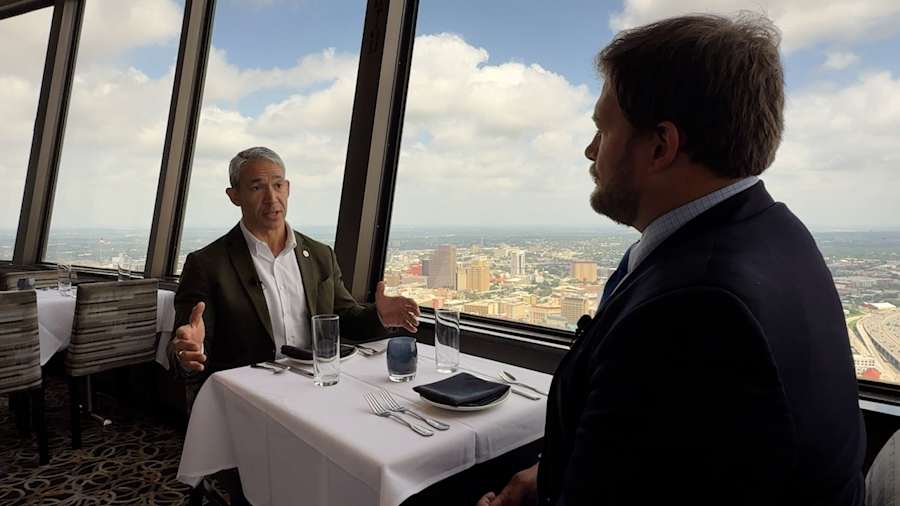
KSAT: One of the other big projects that you had — and it had to take a little bit of a back burner at the time when COVID hit — was transportation and mass transit. Now, as you just mentioned, ART (Advanced Rapid Transit) just breaking ground now. Can you talk about how do you think that’s really going to develop the city or change its course? Because, I think for many skeptics, you look at it, it’s a bus train. And is that enough to really overhaul mass transit in a city of this size?
NIRENBERG: So, I’ll start with that first one. This is one of the largest cities in America without a mass transit system. In order for us to build a mass transit system that will actually touch people, that will be accessible to people, it’s got to be fairly sizable because this is a very sprawling city. And so, we’re building an ART system that is flexible, that feels like, if you are riding it, you would feel like you’re on a rail. But it’s flexible. It’s much cheaper, and we’re now breaking ground on it faster than we thought we would.
And so, we’re going to be able to scale mass transit in this city with the ART system that was approved by voters faster than we would even dream of being able to do with a light rail system. If one day our community desires to take the next step and go to a rail, it will look and feel very similar to what we’re building now, but it will have to be voter-approved.
KSAT: Right now, where we’re sitting, we’re looking over some of the nicest parts of the city, some of the highest-priced real estate, but affordable housing has been an issue for years. The housing bond was one of the council’s attempts to try to address that. We’re talking about another one. You have the SHIP (Strategic Housing Implementation Plan) looking at how to handle housing. So, it’s been a hallmark of your administration and your time in council, but at the same time, we’ve had issues like the ballpark project.
As a matter of trying to develop the surrounding area, destroying some of the lowest-priced housing nearby, some of (the) last remnants of that in downtown. I know it’s not technically “affordable,” but it’s still a couple hundred bucks.
NIRENBERG: Well, it’s also not destroying it. Let me tell you, there’s been a lot of, unfortunately, a lot of misinformation about how that — what that project is and what it will do. The Soap Factory unit development is privately owned. It is also a privately-owned development that will be renovated. And so, when that happens in a market-rate housing unit, it will increase the value of that property. So, by virtue of this development, now we can intervene in that process, and we can ensure that the folks who live there are taken care of. And so, that’s why we have developed the process, not only to bring a ballpark downtown, but also to improve housing and increase the number of affordable housing units, but also (to) protect the residents that are in the units currently who do not have income protection.
And so, it’s going (to) play out over the next several years, but it is not destroying housing. In fact, it’s increasing the amount of housing that’s downtown. And at the very root of our housing affordability crisis in America is two things. One: it’s (that) we do not have the supply of housing enough to meet demand in this country, so we’re increasing the supply. The other one is wages are not rising — are not keeping pace with the cost of housing. So, you’ve got to make sure that people have access to good jobs and good wages, and we’ve got to be sure that we’re building enough housing. This project will do both.
KSAT: Looking back from eight years ago to now, do you think this is a more or less affordable city to live in, and how much of a role do you think your policies or other city policies have played in to that change or lack thereof?
NIRENBERG: So, there’s no doubt in America — and even in Texas — our housing prices have skyrocketed. I think it’s upwards of 40, 50%. But, at the same time, what you’ve seen in San Antonio is that our wages have increased faster than the rise of housing. And so, San Antonio today, despite the rise in housing costs nationwide, is more affordable in terms of the average income than we were before. And so, that’s what I’m talking about. It’s not just (that) we focus all of our efforts on housing and we can leave all the other systems of our economy alone. We’ve got to make sure that this is the dynamic that’s playing out. Cost of living is not outpacing people’s wages, and that’s finally what we’re doing here in San Antonio.
KSAT: Are there any other issues that you think were hallmarks of your administration or your time in office? Covered the three that I always think of. Although I suppose there’s not so much an issue as an enormous boulder in the middle of this was the COVID-19 pandemic.
So, can you tell me how did the pandemic change how you approached the job and how did it change, do you think, your ability to make change? You became one of the most familiar faces in the city — on TV every night for, I don’t even recall how long, next to (former Bexar County) Judge (Nelson) Wolff giving updates. So, how did that change how you approached the job and how you were able to, I guess, pull on the different levers of power?
KSAT: Well, the pandemic obviously was a very challenging moment for all of us. And my approach, and Judge Wolff’s approach, was to provide our community a level of comfort through (a) transparent exchange of information. It was a lot of chaos. We didn’t have a blueprint or a playbook for this. So, what we were trying to do is give folks access to the information so they can protect themselves and their families and give them some comfort and consistency that they weren’t getting anywhere else. That afforded us a level of trust through transparency that allowed us to, I think, see the pandemic for what it has now become, which is a catalyst for changing the level of resilience that we have in this community.
I always think about the lines at the food bank immediately after the pandemic began. We had 120,000 people in this community that needed the food bank just to put food on the table. Literally, a few weeks after, we had some of the best economic times of our lives here in San Antonio. Unemployment was at 3.7 percent before the pandemic began, and all of a sudden people needed to be going to the food bank to put food on the table. That told me there was a level of economic desperation that existed prior to the pandemic that we needed to address. So, we invested in education, access to alternative transportation so it doesn’t cost so much just to get to your job. We continue to do our work on housing.
The pandemic became a catalyst for change to make sure that we’re focusing our priorities correctly in this city and using our resources to build resilience — financial resilience within each San Antonio family. To me, that was why that moment was so important for us.
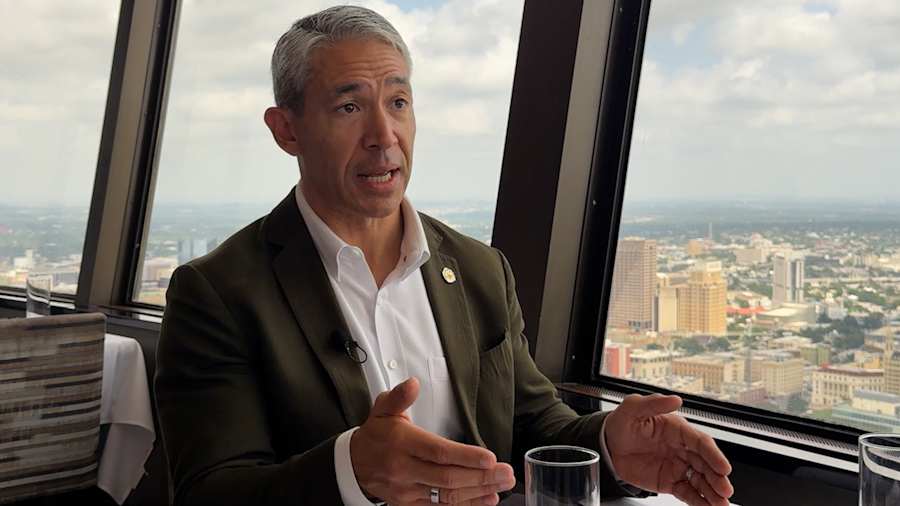
KSAT: For eight years, you’ve been the mayor of the city. For a lot longer, you’ve been a husband, and you’re also a father. Can you talk about trying to balance eight years of leading the city through every problem or issue that arises, while also trying to be there for your son. He’s now... I mean he’s about to go off to college, right?
NIRENBERG: Well, he’s going to be a senior in high school.
KSAT: Senior. OK, one more year.
NIRENBERG: But he’s about to turn 17, and I think about that a lot because when I came into the office — when I came into city council, he was barely four years old. And so, you miss a lot of time. But it’s certainly a different family environment being in this work. It is a sacrifice on the part of the family that you have, to be able to serve. At the same time, I’m grateful for them. And they are grateful for this community because the entire city becomes part of your extended family. And there have been difficult moments, but this is a cherished time for my family. And I feel very blessed that they have always been with me during these really intense moments of San Antonio’s history.
The other part of this is, there’s no such thing as work-life balance in a job like this. But I will say that the challenges of this work make it such that I could not do this work without Erica and Jonah. They give me a perspective, and they ground me in a way that allows me to be effective as a mayor and as a representative of the city. And I’m extraordinarily proud to be Erica’s husband and Jonah’s dad. They give me my report card every single day.
LEAVING THE RESTAURANT AND HEADING TO THE OBSERVATION DECK
KSAT: I suppose we’ve talked about a number of issues so far. You mentioned in your farewell speech - you referenced a headline, I think that was from The (San Antonio) Current, about you’re leaving things undone, which you said that was kind of the point. Can you talk about the things you’re leaving undone, and what do you think you’ve been able to close the book on?
NIRENBERG: Well, as I mentioned, all the meaningful work, the really meaningful work — and I’m proud of the airport, too. And that’s a project that is going to continue. The meaningful work is never started and finished in a mayoral administration.
The work that we do to uplift economic opportunity in this city, to create an environment for safe, affordable, quality housing, to grow a transportation system in the fastest-growing city in the United States, that’s stuff that continues on. And so, I think about these things as systems. And if you put a system together — and it’s aligned in the community — and it’s moving in the right direction, that’s what you want. And so, it’s going to continue.
These things are never done. Maybe one day we’ll finish the airport. But that takes a long time. So yeah, it’s not done, but we’ve set the systems up for success, and now they can accelerate.
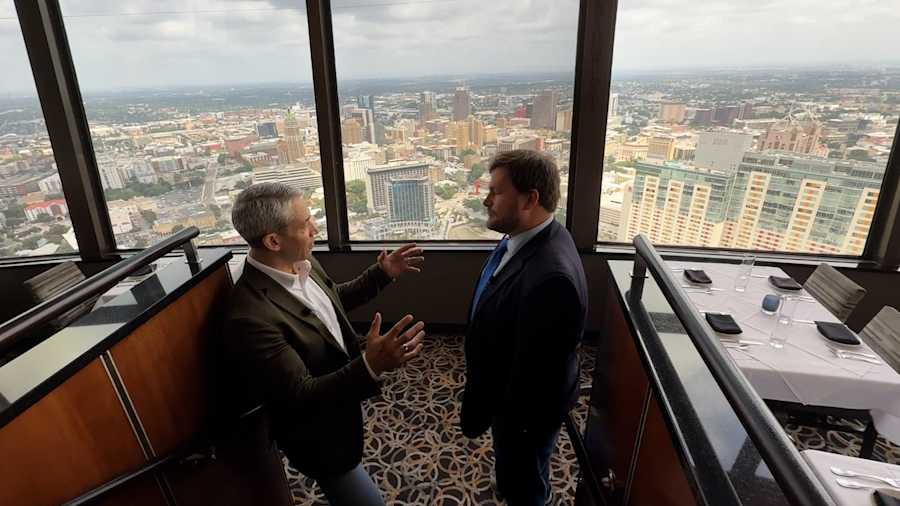
KSAT: Infrastructure has been a constant challenge for the city for years. And I think yesterday (June 12), with the flooding probably illustrated that again. So, I’m wondering, what do you think the status is of the city’s infrastructure at the moment? And where do we need to prioritize investing going forward, keeping in mind what happened yesterday, especially?
NIRENBERG: Well, flood control infrastructure has been one of the constant stories of San Antonio’s modern history, even dating back 30, 40 years ago. The reality is this is, again, a growing city. And so, we’re going to have to continue to build new infrastructure.
At the same time, it’s a 300-year-old city, and so, the need to upgrade old infrastructure is always there, both in terms of things like flood mitigation because communities north of San Antonio are growing, but also climate mitigation. We have to make our — we have to build more durable, resilient infrastructure. At the same time, we’ve got to build brand new stuff. The work that I’ve — I had been focused on, in addition to that, though, has to deal with equity. I mean, we’ve got historic neighborhoods in San Antonio, where people have lived for 100-plus years that don’t even have sidewalks for children to go to school, to get to their bus stop, you know? They’re walking in the mud when it rains.
And so, in a modern city like that, not only do we have to build because it’s growing, reconstruct and maintain because the climate is intense and changing, but we also have to building some equity so that tax-paying families of San Antonio can expect basic infrastructure no matter what part of town they live in.
ON THE TOWER’s OBSERVATION DECK
KSAT: We’re looking over the East Side, which is one of the prime examples of — both the East and West side — of victims of redlining, unequal treatment when it comes to city investment. Are we bridging the gap? Or is this still a tale of cities within one total city. Where lives are — people are living drastically different lives based on the neighborhood they grow up in?
NIRENBERG: That’s the story of socioeconomic inequity and generational poverty, and that’s why I believe San Antonio has a very good story to share.
In 2017, before my first budget, we introduced the equity framework. And that meant that we’re no longer just going to cut everything up by 10 and give everybody one-tenth of the pie. We’re going to look at where the needs are the most, and we’re going start to move the needle to ensure that some areas of town that have simply been falling further and further behind can start to be lifted up. Obviously, Rome wasn’t built in a day, and we have generations of impact from redlining that have to be undone and brought to parity. It’s going to take time, but what I’m very proud of is that San Antonio was one of the first cities in the country to introduce this way of allocating resources, and we have stuck to it.
For eight years that I had the opportunity to put together a budget, it has been built on equity. I would expect that the council is going to continue in that direction. If we can do that — continue to stay committed to that — we’re going to start to — or we’re going to continue to uplift these communities. And it’s going to take a constant effort, though. Two things can be true at the same time. You can be not where you want to be, but you could also be moving in that direction, and that’s where we are in San Antonio. We’re not where we need to be, but we’re moving in the right direction.
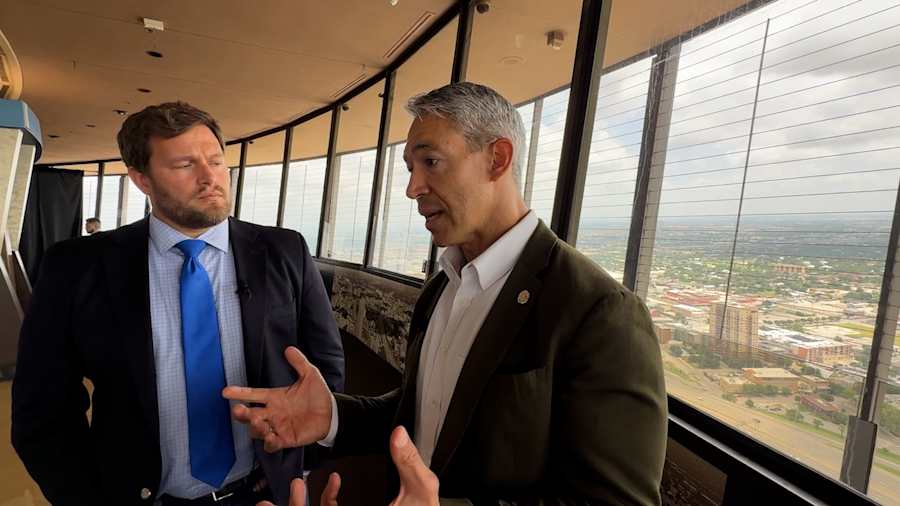
KSAT: I think this was an analogy you’ve used before, but you’re handing off the baton. What’s in that baton that you’re handling off to the next mayor and council? What are the big things you want to make sure they don’t drop?
NIRENBERG: Again, it’s the big pillars of our approach to economic opportunity. It’s the investments in housing, education, and workforce, including adult workers who are locked in these cycles of poverty wage jobs that are also raising children who now are more likely to be in poverty themselves — breaking that cycle through programs like Ready to Work. Our transportation system, which is going to constantly evolve and improve. Our airport, but also it’s the social cohesion. And it’s the really laser focus on the hopes and aspirations of the people in this community. So, that’s the baton. And it’s work that’s going to probably outlast the next several administrations, but we’ve got to keep on track.
KSAT: The incoming mayor, Gina Ortiz Jones, you chose not to endorse her during the runoff against Rolando Pablos. You’ve been active in Democratic politics. This turned into a partisan race. Can you talk about your decision not to endorse anybody? You had indicated during the original election, you might wait until the runoff, but then there was no endorsement during the runoff either.
NIRENBERG: Yeah, and I visited with both candidates and I told both of them, “Whoever becomes mayor, I’m going to help make sure that this city can be successful under their leadership.” And that’s exactly what I’m going to do. So, I’m very excited about Mayor Ortiz Jones’ leadership and what she’s gonna do for this city. I’m excited about the people that she’s going to serve with on the city council. And that’s going be my focus going forward is: how can I be helpful to ensure there’s a good transition but also this community’s needs are continuing to be met? So we have a lot to look forward to.
KSAT: Have you been able to sit down and talk with her since her election?
NIRENBERG: Oh yeah.
KSAT: And what have you shared with her? What have you tried to make sure she understands before she takes office?
NIRENBERG: Yeah, and we have been meeting fairly constantly and talking fairly constantly. There’s a lot, obviously. City Hall is a massive bureaucracy and organization, and to be a successful mayor, you have to be able to navigate it. Gotta also be able (to) work with your colleagues in a way that helps them with their political goals, as well. So, she’s absorbing a lot right now. The things that we have talked about are largely what we’re talking about now: the direction that we’re in, or the direction we’re going in, the kinds of challenges that we are beginning to overcome, and again, the fact that this is one big team — San Antonio — and there’s a lot of folks that we’ll have to put into place to make sure that we continue to operate well.
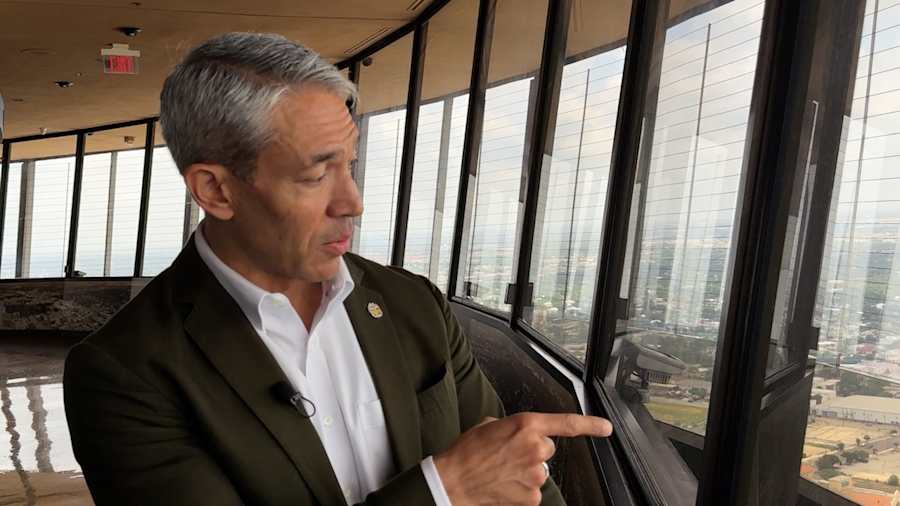
KSAT: Funny you should mention “team” because right over here...
NIRENBERG: *Laughs* Of course.
KSAT: …ITC site already partially demolished, possible future home of a Spurs arena and an anchor point for a pretty controversial multi-billion dollar reimagining of downtown: the sports and entertainment district, Project Marvel. When voters have been polled, it hasn’t proven to be very popular. It became a campaign issue. What’s your outgoing sales pitch to the new council and to the citizens who are skeptical?
NIRENBERG: Well, so it’s controversial because you’re polling things when there’s not a whole lot of the details put together yet. And that’s the reality is that right now, Project Marvel, which is essentially shorthand for all of these different projects that are taking place downtown, is a concept; it’s not a plan. And so, what we are seeking to do is — considering the fact that there’s the Alamo redevelopment happening right now. UTSA is building a campus downtown. The Alamodome, which is a very important venue for San Antonio, is 30 years old, and it needs some upgrades. The Convention Center is gonna be expanding. Hemisfair is under a massive redevelopment in and of itself.
Because of all these things, we need some serious infrastructure upgrades. So, because all those things are happening downtown, let’s have a more comprehensive strategy for doing that work. That’s what Project Marvel is. And if we can do that and also bring the Spurs to the heart of the city — where a lot of folks thought they should have never left — that can be a catalytic moment for our entire city. You already have one of the most unique downtowns in America. We wanna make it more inviting for local residents, not just tourists. And so, if we can do all that work in a way that, again, accomplishes this vision and we can do it affordably with prudence for the San Antonio taxpayer, that will be one of the best things we could do to uplift this city.
I’m confident it’s going to happen because, No. 1, we’re going to put together a plan — or the administration will put together a plan — that’s financially sound, that’s also not putting this on the back of residential taxpayers. But also, it’s at a moment where we’re doing all the basics in San Antonio. These are nice amenities for this community to have. You can’t build those amenities unless you’re already — you’re also taking care of the basics, and we’re doing that here in San Antonio."
KSAT: The Spurs arena, in particular, has been the most controversial part of it. While there won’t be...a direct sales tax for most people, such as we had with the Alamodome, there is the (Bexar County) Venue Tax. There is the PFZ (Project Financing Zone). There is TIRZ (Tax Increment Reinvestment Zone). And no matter how you shape those, these are public dollars, and whether or not they’re coming out of your average San Antonian’s pockets, it’s still money that could be spent on their behalf. Perhaps elsewhere...
NIRENBERG: On hotels and other visitor luxuries. So that’s the thing...
KSAT: But you could do more than that with TIRZ. You don’t have to just spend it on hotels.
NIRENBERG: Well, so let’s talk about the TIRZ. The TIRZ is an increment of the property tax that’s being paid right now. The TIRZ only improves — that increment doesn’t come in unless there’s development that happens. And so, the development is going to happen because we are requiring it as part of Project Marvel. If it doesn’t happen, there’s no money there. And so, the TIRZ is only possible because Project Marvel will happen. If Project Marvel doesn’t happen, there’s no TIRZ money to begin with. So, that’s number one. The PFZ and the (Bexar County) Venue Tax: those two things are specifically explicitly for venues like what we’re talking about with the arena. And so...
KSAT: It’s also been used, however, for improving the river and making local arenas, too. So it’s not -
NIRENBERG: 100%.
KSAT: It’s not just the Spurs.
NIRENBERG: That’s right.
KSAT: The (Bexar County) Venue Tax has been tapped.
NIRENBERG: And that’s exactly why the county has come up with a plan to split that revenue to take care of other venues besides the arena. And that is what I am talking about.
As long as we are doing this prudently and getting the priorities done through the community input process that our community wants to see in addition to a Spurs arena, the dollars that are flowing to a Spurs arena, including a massive investment from the Spurs themselves, is exactly how we should model these deals — these arena proposal(s) in the future.
This is not 1995 in terms of building a Spurs arena. We’re not putting this on the backs of San Antonio taxpayers the way it has been done all around this country for years and years. We’re being much smarter and getting our community’s goals accomplished at the same time. We’re bringing the Spurs back down for local residents to see in the place — the urban core — where people congregate to begin with.
KSAT: But what about even just the simple appearance of you’re spending public money at a time when we just enumerated all the pressures facing San Antonio residents — you’re spending money on essentially a luxury?
NIRENBERG: That’s why I hope moving forward, Garrett, there is really detailed and thoughtful reporting of the subject because let’s talk about each and every single one of those revenue streams. The TIRZ doesn’t happen unless those developments occur through Project Marvel. So, there’s no money there. That’s not an opportunity cost. The PFZ: if we don’t invest the PFZ in San Antonio, it goes to Lubbock and Houston and all the other cities in the state.
KSAT: You’re referencing because that would be a state tax — that we’re taking (a) state tax.
NIRENBERG: It’s dollars that are coming back to us that we’re reclaiming from the state. And if we don’t do that, it’s going to go to other parts of the state. The (Bexar County) Venue Tax, as you said, is for venues. And so, as long as we’re doing that prudently, according to what the public wants, it’s going to go to venues. So, these are not opportunity costs from streets, and sidewalks, and housing projects and all that. We’re doing this in a way that is utilizing those revenue streams precisely for why they were created.
KSAT: You’re going to be handing the reins over to (a) new council, who may have different ideas. The mayor-elect has been critical of this project — hasn’t been completely against it, but has said she thinks it needs to be tied to other things.
We’ve heard from other incoming council candidates and some returning council members that they’re reluctant to fully embrace Project Marvel right now. With the new council, and also possibly voters weighing in on this in November, either through a Venue Tax election or even the bonds surrounding developing...
NIRENBERG: Streets and sidewalks.
KSAT: The surrounding area... But you’ve got voters and you’ve got a new council, who could somehow possibly derail or change the trajectory of Project Marvel, or the Spurs arena in particular. What do you think happens if that arena does not get built as planned right now?
NIRENBERG: First of all, I think it will get built, and that’s because it’s a prudent deal. And let’s talk about the Spurs. I mean, we love our Spurs, they’re part of our culture. But let’s look at Spurs vis-a-vis all the other franchises in the NBA and beyond in this country. There is not a more actively community-engaged franchise in professional sports than the San Antonio Spurs. I mean, every single day, they’re investing dollars and time into this community. And they’re gonna do that with this arena, as well. And so, if you compare what the Spurs are doing in this community and doing with this potential development with any other city in the country, I will put that up against any franchise.
The other thing is: let’s be realistic. The Spurs are on the cusp of being one of the dynasties again, given the makeup of the team, and the investments, and the improvements that they’re making. You’ve got major cities like Seattle and Las Vegas, and even up the road that would love to have that — that opportunity in their city. And that’s not the motivator because the Spurs are not going anywhere, and the Spurs don’t want to be out of San Antonio. But let’s just be clear: we shouldn’t allow other folks to even think that we have no interest in keeping the Spurs.
And so. they’re gonna have an active role to play, and we’re going (to do a) prudent deal that doesn’t put this on the backs of taxpayers. But we’re also going to show that the San Antonio Spurs are here to stay, and that’s a partnership. So, I’m excited about the opportunity. I don’t think that this deal would be possible if it weren’t the Spurs because any other franchise in the country would expect taxpayers in San Antonio to shell out a lot of money because we’re still a growing market. And so, one day we’re going to be past that.
But today in San Antonio, the San Antonio Spurs are here to stay, and they’re an active part of the investments that are occurring in our city.
KSAT: People “up the road.” Austin’s the city who shall not be named, huh?
NIRENBERG: Well, I don’t think that’s going (to) happen, and nor do I think they’re going anywhere. And they have never said that, and in fact (Spurs governor) Peter Holt has said completely the opposite: they are San Antonio through and through.
But my point is, they’re also a franchise that any other city in the country would love to have. So, let’s just do what we know how to do and put together a prudent deal, get community input, but also make sure that the Spurs are paying their fair share as we use the revenues explicitly created for these kinds of venues to create this venue.
ON THE TOWER OF THE AMERICAS’ OUTSIDE OBSERVATION DECK
KSAT: What’s your favorite part of the view?
NIRENBERG: The quietness from up here. Just the sound of the wind.
KSAT: Plenty of noise at City Hall.
NIRENBERG: Yeah, yeah. No, and every time you come up here... it’s a city in transition and transformation — in good transformation, you know? Lone Star Development is down there. That’s going to change. It’s an abandoned brewery complex that will also be transformative, per se. So, there’s so many different things in a 300-plus-year-old city that are dynamic and new. Historic. I like looking at the Alamo from here because you can see the modern city that has grown up around it.

KSAT: Two more questions, and then we’ll be done. First off, what’s next? You’re going (to) be taking the professor post, but I understand that’s what, part-time?
NIRENBERG: Yeah.
KSAT: And a lot of people have speculated that you might have further political ambitions. So, what do you think the future holds for you, politics-wise?
NIRENBERG: I’m not sure yet, but as I said at the beginning, my focus has been on having a positive impact on my community, and I’ve fallen in love with public service. So if there’s a place I can continue to make a positive impact, I have deep concerns about the lack of foresight that’s going on in many areas of government right now and the fact that we’re under-investing in our education system, our public education system. The fact that if not for Bexar County and San Antonio investing in our health system and our mental health infrastructure, we would be having really serious problems — beyond what we see currently — in homelessness, and mental health issues, and drug abuse, if not for our own local investments, when it’s actually, in fact, the state’s responsibility. So, there’s so many things that I think if we’ve got alignment, we would be better off, and certainly communities would be able to thrive.
This is the United States. We have all the resources in our — that we would ever need to ensure that every family in these communities can thrive. But it’s politics that’s preventing that. And so, I’m interested in continuing to make (an) impact. I have no idea — or I don’t know yet — what that means for the future, but I don’t think I’m done with public service.
KSAT: Brief follow-up: what’s your immediate plans? Once Wednesday comes, you canvass those results, new council and mayor sworn in.
NIRENBERG: I’m going to take a mini-sabbatical. I’ve been on call for 16 years. And so I’m gonna take a brief pause to reflect, meditate, pray and clear out some of this adrenaline that’s been running through me for the last many years, six particularly with the pandemic.
KSAT: Last one. You gonna miss it?
NIRENBERG: Of course, I’ll miss the people I get to work with every day. I’ll miss having the ability to have direct impact on certain things. But look, I’m a big believer in term limits. There is a moment where you need to step away, provide for fresh perspective and energy, and I think that moment is now. But I’m excited about the future for San Antonio.
KSAT: Thanks for the time, Mayor.
NIRENBERG: Thanks, Garrett.
